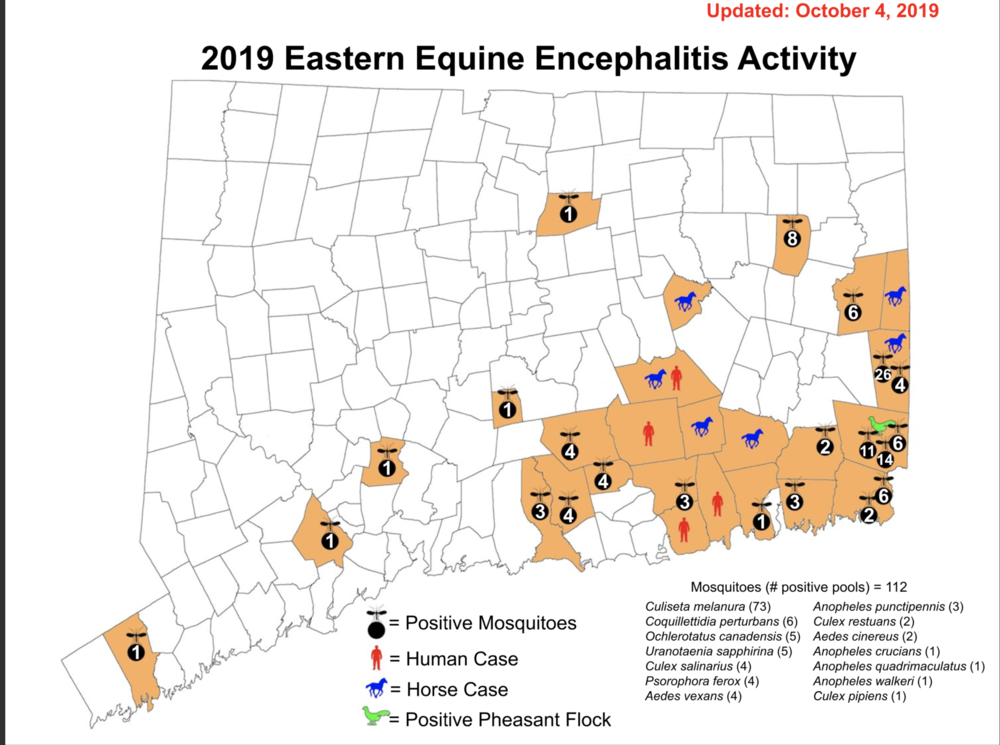(Updated on Oct. 7, 10:17 a.m.)
Three people have died in eastern Connecticut after contracting Eastern Equine Encephalitis from mosquitoes carrying the EEE virus, and a fourth person remains hospitalized with EEE, according to a Connecticut Department of Public Health press release from Oct. 1.
Scientists are testing mosquitoes across the state for the EEE virus and as of Oct. 5 The Connecticut Agricultural Experiment Station reported that 19 towns have found EEE-positive mosquitoes. While no mosquitoes carrying the virus have been detected in Hamden, North Haven or New Haven, local officials, including those at Quinnipiac, are urging residents to avoid the outdoors between dusk and dawn when the mosquitoes are most active.

According to CAES, these are the locations that have tested positive for mosquito pools in Connecticut.
Starting on Oct. 1, Mayor Curt Balzano Leng suspended town and school activities from dusk until dawn at the recommendation of the regional public health organization, the Quinnipiack Valley Health District. Officials are taking extra precautions to limit resident exposure to mosquitoes after scientists found insects carrying the virus in Bethany. Public health officials note that the species of mosquito found in Bethany does not typically bite humans, but commonly feeds on birds.
Health District Recommends Suspending Outdoor Activities from
Dusk to Dawn Due to Mosquito EEE Virus PrecautionQVHD has recommended the suspension of school and town sponsored activities at dawn or dusk, when mosquitos are most active…. https://t.co/b5drvnEA5r
— Curt Balzano Leng (@curtleng) September 28, 2019
Quinnipiac officials are also taking caution, restricting outdoor activities and events that occur just after the sun sets and rises.
Connecticut Governor Ned Lamont issued a press release on Sept. 24 warning residents to be careful, but not panic, after the first person died from EEE this year. Officials have also put up warning signs on highways all over the state to spread the message and encourage people to “avoid outdoors [at] dusk and dawn” even in towns where EEE infected mosquitoes have not been found. (Click on the image below to see the full message of the sign near the I-95 on-ramp in Milford).
Connecticut isn’t alone, as local news outlets report Rhode Island has experienced three human cases and one death from EEE. Massachusetts has experienced 11 human cases and four deaths.
Steve Mansfield, the health director of the Ledge Light District, which includes much of eastern Connecticut, was one of the first health officials to deal with re-emergence of EEE in the state.
“We were contacted by the state department of epidemiology a few weeks ago to notify us about the first positive mosquito pools in Connecticut,” Mansfield said. “The most important thing now is we’re waiting for a hard frost because that’s how the mosquitos will die.”
Mansfield explained that the EEE virus is relatively uncommon. Prior to this year, Connecticut had not seen any cases of EEE since 2013.
“Although the disease is very severe, it’s between 30 to 50 percent fatality rate and it’s extremely rare,” Mansfield said.
Mansfield further explained that people who survive EEE typically suffer from cognitive impairment, such as impaired memory or dementia. Some symptoms of EEE include chills, fever, malaise (discomfort), arthralgia (joint pain), and myalgia (muscle pain). Symptoms don’t typically show up until three to ten days after a bite.
Towns across the state are taking different measures to protect residents.
Concerns about the virus have spread to high school athletics, which have postponed or moved up events, according to Twitter accounts from Xavier High School, Stonington High School, Ledyard High School and Windsor public schools.
Stonington 40, Montville 34 – Final
suspended after 3 quarters EEE restrictions until Saturday, 10 a.m. #cthsfb— CIAC Football (@ciacfb) September 14, 2019
Mosquitoes in the area have tested for EEE, leading to other games getting postponed. #cthsfb
— Dave Ruden (@DaveRuden) September 13, 2019
Health officials say that limiting exposure to mosquitoes is a quick way to act upon the virus.
“I think it’s preventive, very cautious and assuring that people who do not want to take action against mosquito bites are not caught off guard,” said Balch of QVHD. “I don’t think it’s necessary in every town of the state to try to prevent mosquito bites.”
Mansfield added that Connecticut residents can take further steps to protect themselves.
“People can minimize outdoor activity around dusk and dawn, wear long sleeves or protective clothing that can cover as much skin as possible,” Mansfield said. “That’s the most effective way to prevent the disease.”
But getting the correct information out to the public is also key.
“We field a lot of phone calls from people who are very concerned and haven’t done their research,” said Mansfield. “They start asking questions, so the most important thing is spreading that message.”
Balch of the Quinnipiack Valley Health District wants residents to feel comfortable contacting her office for more information and guidance.
“I do feel for anyone who is confused by the multiple messages or the level of messaging that’s going out from different areas of the state,” Balch said.
“Whether it’d be the media, department of transportation, from one town to the next town they must find it very confusing. I want them feeling comfortable calling the health department.”
To reach a public health official at QVHD, residents can call 203-248-4528.

